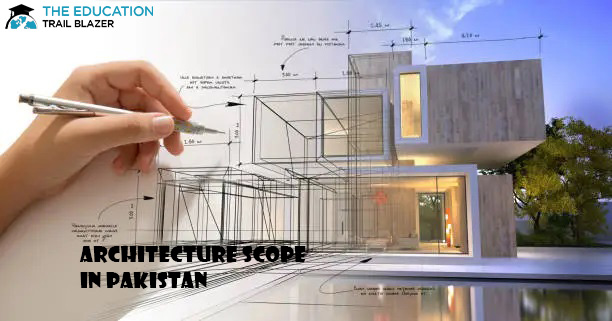Architecture is the art and science of designing and constructing buildings and other structures that are functional, aesthetic, and sustainable. Architecture is one of the most creative and rewarding fields of study and work in Pakistan. Architectural Scope in Pakistan offers many benefits and opportunities for students and professionals, such as:
- Creativity: Architecture allows you to use your imagination and creativity to create unique and innovative designs and structures that reflect your vision and style.
- Impact: Architecture enables you to make a positive impact on society by improving the quality of life, health, safety, environment, and culture of the people and places you design for.
- Diversity: Architecture covers a wide range of disciplines and domains that cater to different interests, skills, and passions. You can design for various types of buildings and structures such as residential, commercial, institutional, cultural, recreational, etc.
- Growth: Architecture is a dynamic and evolving field that offers many opportunities for learning, development, and advancement. You can explore new technologies, trends, and innovations in architecture that can enhance your skills and knowledge.
- Reward: Architecture is a lucrative and rewarding field that offers attractive salaries and compensation packages for qualified and skilled professionals.
However, choosing architecture as your career choice in Pakistan can be a challenging and complex task for many students and professionals. There are many factors to consider, such as:
- Interest: You should choose architecture if you have a genuine interest, passion, and curiosity for designing and constructing buildings and structures.
- Aptitude: You should choose architecture if you have a good aptitude, abilities, and talents for drawing, sketching, modeling, visualizing, etc.
- Scope: You should choose architecture if you have a clear understanding of the scope, demand, and potential of architecture in the current and future market.
- Salary: You should choose architecture if you have realistic expectations of the salary and compensation that you can earn as an architect in Pakistan.
To help you make an informed and wise decision, we have prepared a comprehensive guide on architecture scope in Pakistan based on various criteria such as interest, aptitude, scope, salary, etc. We have also provided a brief introduction and overview of each aspect of architecture scope in Pakistan along with its challenges and opportunities. So, let’s get started.
Architecture Scope in Pakistan Background
Architecture is one of the oldest and most fundamental human activities. It has been practiced since ancient times by various civilizations and cultures across the world. Architecture reflects the history, culture, values, beliefs, and aspirations of the people who create it. Architecture also influences the way people live, work, play, learn, worship, etc.
Architecture in Pakistan has a rich and diverse history that spans over thousands of years. It has been influenced by various factors such as geography, climate, religion, politics, economy, etc. Architecture in Pakistan has also been influenced by various styles and movements such as Indus Valley Civilization, Buddhist, Hindu, Islamic, Mughal, British, Modern, Contemporary, etc.
Purpose of the Study
The purpose of this study is to provide you with a comprehensive guide on architecture scope in Pakistan. This study will help you to:
- Understand the meaning and definition of architecture and its disciplines and domains.
- Learn about the historical perspective and evolution of architecture in Pakistan and its influences and styles.
- Explore the architectural education and training in Pakistan and its institutes and universities, curriculum and specializations, challenges and opportunities.
- Discover the architectural firms and practices in Pakistan and their prominent firms and projects, role and impact on urban development.
- Analyze the government policies and regulations on architecture in Pakistan and their building codes and regulations, sustainability and green building initiatives, impact on architectural practices.
- Evaluate the challenges and opportunities for architecture in Pakistan and their economic factors, socio-cultural factors, environmental sustainability, future prospects.
- Identify the architectural trends and innovations in Pakistan and their technology in architecture, sustainable architecture, integration of local culture.
- Appreciate the architectural icons of Pakistan and their landmark buildings and architects who shaped the landscape.
Scope of the Topic
The scope of this topic is to cover all the aspects of architecture scope in Pakistan based on various criteria such as interest, aptitude, scope, salary, etc. This topic will provide you with a comprehensive guide on architecture scope in Pakistan that will help you to make an informed and wise decision about choosing architecture as your career choice in Pakistan. This topic will also provide you with valuable information and insights about the current and future state of architecture in Pakistan that will help you to prepare yourself for the challenges and opportunities that await you as an architect in Pakistan.
Historical Perspective
Architecture in Pakistan has a rich and diverse history that spans over thousands of years. It has been influenced by various factors such as geography, climate, religion, politics, economy, etc. Architecture in Pakistan has also been influenced by various styles and movements such as Indus Valley Civilization, Buddhist, Hindu, Islamic, Mughal, British, Modern, Contemporary, etc.
Evolution of Architecture in Pakistan
The evolution of architecture in Pakistan can be traced back to the Indus Valley Civilization (2500-1500 BC), which was one of the earliest and most advanced urban civilizations in the world. The Indus Valley Civilization is known for its remarkable achievements in urban planning, sanitation, drainage, water supply, and public works.
The Indus Valley CivilizationThe Indus Valley Civilization declined around 1500 BC due to various reasons such as natural disasters, climate change, invasion, etc. After the decline of the Indus Valley Civilization, various other cultures and civilizations emerged and flourished in the region such as the Gandhara Civilization (6th century BC – 5th century AD), the Mauryan Empire (4th – 2nd century BC), the Kushan Empire (1st – 3rd century AD), the Gupta Empire (4th – 6th century AD), etc. These cultures and civilizations introduced various architectural styles and influences such as Buddhist, Hindu, Greek, Persian, etc.
The Islamic conquest of the region began in the 7th century AD by the Arabs and continued by various other Muslim dynasties such as the Ghaznavids (10th – 12th century AD), the Ghurids (12th – 13th century AD), the Delhi Sultanate (13th – 16th century AD), etc. These Muslim dynasties introduced various architectural styles and influences such as Arab, Turkish, Persian, Mongol, etc.
The Mughal Empire (16th – 18th century AD) was one of the most powerful and prosperous empires in the world. It was founded by Babur, a descendant of Timur and Genghis Khan. The Mughal Empire reached its peak under Akbar, Jahangir, Shah Jahan, and Aurangzeb. The Mughal Empire is known for its remarkable achievements in art, culture, literature, and architecture. The Mughal Empire introduced a unique and distinctive style of architecture that blended the Islamic, Persian, Turkish, Indian, and European styles and influences.
The British Raj (1858 – 1947) was the period of British colonial rule in the Indian subcontinent. It was established after the Sepoy Mutiny of 1857, which was a rebellion against the British East India Company. The British Raj had a significant impact on the political, economic, social, and cultural aspects of the region. The British Raj also had a significant impact on the architecture of the region. The British Raj introduced various architectural styles and influences such as Gothic, Victorian, Edwardian, Neo-Classical, etc.
The Modern Era (1947 – present) is the period after the independence and partition of India and Pakistan in 1947. It is marked by various political, economic, social, and cultural changes and challenges in both countries. The Modern Era also witnessed various changes and developments in the architecture of both countries. The Modern Era introduced various architectural styles and movements such as Modernism, Post-Modernism, Regionalism, etc.
These are some of the major phases and features of the evolution of architecture in Pakistan that have shaped its history and identity over time. Pakistani architecture is a reflection and expression of its culture and diversity that is unique and varied in its own way.
These are some of the major phases and features of the evolution of architecture in Pakistan that have shaped its history and identity over time. Pakistani architecture is a reflection and expression of its culture and diversity that is unique and varied in its own way.
Influences on Pakistani Architecture
Pakistani architecture has been influenced by various factors such as geography, climate, religion, politics, economy, etc. Some of the major influences on Pakistani architecture are:
- Geography: Pakistan is located in South Asia, bordering India, China, Afghanistan, and Iran. It has a diverse and varied geography that ranges from mountains, plateaus, deserts, plains, rivers, coasts, etc. The geography of Pakistan has influenced the architecture of Pakistan in terms of materials, techniques, forms, functions, etc.
- Climate: Pakistan has a continental climate that varies from region to region. It has four seasons: winter, spring, summer, and monsoon. The climate of Pakistan has influenced the architecture of Pakistan in terms of comfort, ventilation, insulation, orientation, etc.
Religion: Pakistan is an Islamic republic that was created in 1947 as a separate homeland for Muslims in India. Islam is the dominant religion in Pakistan that has influenced the architecture of Pakistan in terms of symbolism, expression, identity, etc. - Politics: Pakistan has a parliamentary democracy that has been marred by various political upheavals and conflicts since its inception. Politics has influenced the architecture of Pakistan in terms of power, prestige, propaganda, etc.
- Economy: Pakistan has a mixed economy that is based on agriculture, industry, and services. Economy has influenced the architecture of Pakistan in terms of development, innovation, diversity, etc.
These are some of the major influences on Pakistani architecture that have shaped its history and evolution over time. Pakistani architecture is a reflection and expression of its culture and identity that is unique and diverse in its own way.
Architectural Styles in Pakistan
Pakistan has a rich and diverse architectural heritage that reflects its history, culture, and identity. Pakistan has witnessed various architectural styles and movements that have influenced its buildings and structures over time. Some of the major architectural styles in Pakistan are:
Traditional Pakistani Architecture
Traditional Pakistani architecture is the indigenous and vernacular style of architecture that developed and evolved in the region over centuries. Traditional Pakistani architecture is characterized by its simplicity, functionality, adaptability, and harmony with nature. Traditional Pakistani architecture is influenced by various factors such as geography, climate, religion, culture, etc.
Modern Architectural Trends
Modern architectural trends are the contemporary and innovative styles of architecture that emerged and flourished in the region in the 20th and 21st centuries. Modern architectural trends are characterized by their experimentation, originality, diversity, and expression. Modern architectural trends are influenced by various factors such as technology, globalization, urbanization, etc.
Fusion of Traditional and Modern Styles
Fusion of traditional and modern styles is the hybrid and eclectic style of architecture that combines and integrates the elements and features of both traditional and modern styles. The fusion of traditional and modern styles is characterized by its diversity, creativity, harmony, and identity. Fusion of traditional and modern styles is influenced by various factors such as culture, heritage, innovation, etc.
Architectural Education in Pakistan
If you are interested and apt for architecture as your career choice in Pakistan, you need to pursue architectural education and training in Pakistan. Architectural education and training in Pakistan is the process of acquiring the knowledge, skills, and qualifications required to become a professional architect in Pakistan.
Architectural Institutes and Universities
Pakistan has various institutes and universities that offer architectural education and training in Pakistan. These institutes and universities are recognized and accredited by various bodies such as the Higher Education Commission (HEC), the Pakistan Council of Architects and Town Planners (PCATP), etc. Some of the prominent architectural institutes and universities in Pakistan are:
- National College of Arts (NCA)
- University of Engineering and Technology (UET)
- Indus Valley School of Art and Architecture (IVS)
- NED University of Engineering and Technology
Curriculum and Specializations
The curriculum and specializations of architectural education and training in Pakistan are designed and developed according to the standards and guidelines of various bodies such as HEC, PCATP, etc.
Challenges and Opportunities
Architecture is a challenging and rewarding field that offers many opportunities and benefits for students and professionals in Pakistan. However, architecture also faces many challenges and difficulties that need to be addressed and overcome in order to achieve its full potential and impact. Some of the major challenges and opportunities for architecture in Pakistan are:
Economic Factors
Economic factors are the factors that affect the financial and material aspects of architecture in Pakistan. Economic factors include the availability, affordability, and quality of resources, materials, technologies, etc. that are required for the design and construction of buildings and structures. Economic factors also include the demand, supply, and value of architectural services, products, projects, etc. that are offered and provided by the architects and firms in Pakistan.
Socio-cultural Factors
Socio-cultural factors are the factors that affect the social and cultural aspects of architecture in Pakistan. Socio-cultural factors include the values, beliefs, norms, customs, traditions, etc. that are prevalent and practiced by the people and society in Pakistan. Socio-cultural factors also include the needs, preferences, expectations, aspirations, etc. that are expressed and desired by the people and society in Pakistan.
Environmental Sustainability
Environmental sustainability is the factor that affects the ecological and environmental aspects of architecture in Pakistan. Environmental sustainability includes the impact, conservation, and enhancement of the natural resources, ecosystems, and biodiversity that are essential for the survival and well-being of architecture and its people and society in Pakistan.
Future Prospects
Architecture is a field that has a lot of potential and prospects for the future in Pakistan. Architecture is a field that can contribute to the development and improvement of the country in various ways such as:
- Economic development
- Social development
- Environmental development
Architectural Trends and Innovations
Architecture is a field that is constantly evolving and innovating with the changing times and needs of the people and society. Architecture is a field that can explore and experiment with new and different technologies, trends, and innovations that can enhance and transform the field of architecture in various ways. Some of the major architectural trends and innovations in Pakistan are:
Technology in Architecture
Technology is one of the most influential and impactful factors that affect and shape architecture in Pakistan. Technology is one of the most powerful and useful tools that can offer new possibilities and opportunities for architecture in Pakistan. Technology can also pose new challenges and threats for architecture in Pakistan.
Architectural Trends and Innovations
Architecture is a field that is constantly evolving and innovating with the changing times and needs of the people and society. Architecture is a field that can explore and experiment with new and different technologies, trends, and innovations that can enhance and transform the field of architecture in various ways. Some of the major architectural trends and innovations in Pakistan are:
Technology in Architecture
Technology is one of the most influential and impactful factors that affect and shape architecture in Pakistan. Technology is one of the most powerful and useful tools that can offer new possibilities and opportunities for architecture in Pakistan. Technology can also pose new challenges and threats for architecture in Pakistan. Some of the notable technologies that are used and applied in architecture in Pakistan are:
- Computer-aided design (CAD): This is the technology that uses computer software and hardware to create, modify, analyze, and optimize architectural designs and drawings. CAD enables architects to work faster, easier, and more accurately with digital models and simulations. CAD also enables architects to communicate and collaborate with other professionals and stakeholders involved in the design and construction process.
- Building information modeling (BIM): This is the technology that uses a digital representation of the physical and functional characteristics of a building or structure. BIM enables architects to create, manage, and share information about a building or structure throughout its life cycle. BIM also enables architects to integrate various aspects of a building or structure such as structure, envelope, services, environment, etc.
- Geographic information system (GIS): This is the technology that uses a system of capturing, storing, analyzing, and displaying spatial data related to a location or area. GIS enables architects to understand and visualize the geographic context and conditions of a site or project. GIS also enables architects to plan and design for various factors such as land use, zoning, transportation, infrastructure, etc.
- Virtual reality (VR) and augmented reality (AR): These are the technologies that use computer-generated images and sounds to create an immersive and interactive experience of a simulated or enhanced reality. VR and AR enable architects to visualize and experience their designs and projects in a realistic and engaging way. VR and AR also enable architects to test and evaluate their designs and projects for various aspects such as performance, usability, aesthetics, etc.
Sustainable Architecture
Sustainable architecture is one of the most important and relevant trends and innovations in architecture in Pakistan. Sustainable architecture is the approach and practice of designing and constructing buildings and structures that are environmentally friendly, socially responsible, and economically viable. Sustainable architecture aims to minimize the negative impact and maximize the positive impact of architecture on the environment and society.
Integration of Local Culture
Integration of local culture is one of the most significant and distinctive trends and innovations in architecture in Pakistan. Integration of local culture is the approach and practice of designing and constructing buildings and structures that reflect and respect the local culture and heritage of Pakistan. Integration of local culture aims to preserve and promote the identity and expression of Pakistan and its people and society.
These are some of the major architectural trends and innovations in Pakistan that have influenced and transformed the field of architecture in various ways. Architecture is a field that can explore and experiment with new and different technologies, trends, and innovations that can enhance and improve the field of architecture in Pakistan.
Architectural Icons of Pakistan
Pakistan has a rich and diverse architectural heritage that showcases its history, culture, and identity. Pakistan has many architectural icons that represent and symbolize its achievements, values, and aspirations. Architectural icons are buildings and structures that are famous and recognizable for their design, style, function, or impact. Architectural icons are landmarks and attractions that draw attention and admiration from the people and society in Pakistan and the world. Some of the major architectural icons of Pakistan are:
Landmark Buildings
Landmark buildings are buildings that are notable and prominent for their location, size, shape, or significance. Landmark buildings are buildings that mark or define a place or area in Pakistan. Landmark buildings are buildings that have historical, cultural, or political importance or relevance for Pakistan.
Architects Who Shaped the Landscape
Architects who shaped the landscape are architects who have made significant and influential contributions to the field of architecture in Pakistan. Architects who shaped the landscape are architects who have created and designed many buildings and structures that have defined and transformed the landscape of Pakistan. Architects who shaped the landscape are architects who have inspired and influenced many other architects and students in Pakistan.
FAQs
Here are some of the frequently asked questions (FAQs) about architecture scope in Pakistan:
Q: What is the eligibility criteria for admission to the architecture program in Pakistan?
Completion of 12 years of schooling with at least 60% marks in subjects such as mathematics, physics, chemistry, etc.
Qualification in various entrance tests and exams such as NTS, ECAT, etc. with a minimum score of 50%.
Submission of a portfolio of drawings, sketches, models, etc. that demonstrate your interest and aptitude for architecture.
Appearance in an interview or aptitude test that assesses your personality and potential for architecture.
What is the duration and structure of the architecture program in Pakistan?
The architecture program in Pakistan is usually a 5-year degree program that consists of 10 semesters.
The architecture program in Pakistan is usually divided into two parts: a 3-year Bachelor of Science (B.Sc.) in Architecture and a 2-year Bachelor of Architecture (B.Arch.).
The architecture program in Pakistan usually covers various courses such as design, history, theory, technology, etc. that provide you with the basic and fundamental knowledge and skills of architecture.
The architecture program in Pakistan usually requires you to complete various projects, assignments, internships, etc. that provide you with practical experience and exposure to the field of architecture.
What are the career options and opportunities for architects in Pakistan?
Working as an architect in various sectors and industries such as construction, real estate, hospitality, etc. that require architectural services, products, projects, etc.
Working as an architect in various types and domains of architecture such as residential, commercial, institutional, cultural, recreational, etc. that cater to different interests, skills, and passions.
Working as an architect in various roles and positions such as designer, planner, consultant, manager, educator, researcher, etc. that offer different responsibilities, challenges, and rewards.
Working as an architect in various firms and organizations such as private firms, public firms, government agencies, non-governmental organizations (NGOs), etc. that offer different environments, cultures, and benefits.
Conclusion
Architecture is one of the most creative and rewarding fields of study and work in Pakistan. Architecture offers many benefits and opportunities for students and professionals, such as creativity, impact, diversity, growth, reward, etc. However, choosing architecture as a career choice in Pakistan can be a challenging and complex task for many students and professionals. There are many factors to consider, such as interest, aptitude, scope, salary, etc.
We hope that this guide has inspired you to pursue your passion and curiosity for designing and constructing buildings and structures that are functional, aesthetic, and sustainable. We hope that this guide has motivated you to explore your abilities and talents for drawing, sketching, modeling, visualizing, etc. We hope that this guide has encouraged you to pursue your career goals and aspirations for becoming a professional architect in Pakistan.
Related article





